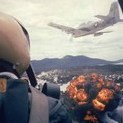Sign in to follow this
Followers
0

Razbam MiG-23MLA Flogger
By
MigBuster, in Digital Combat Simulator Series General Discussion
-
Similar Content
-
By MigBuster
The Boeing CH-47F Chinook fondly referred to as ‘The Hook’ by US military personnel, stands today as the premier multi-mission rotary wing aircraft in use with the US Army, US Army Reserve, National Guard and 20 other nations including Canada, the United Kingdom, Netherlands, Japan, Italy, Greece, Spain, South Korea, Australia, Türkiye, India and the United Arab Emirates. Embodying a unique tandem rotor design this massive helicopter excels in all its roles, including cargo and troop transportation, sling load operations, search and rescue, casualty evacuation, special operations, and humanitarian assistance in disaster scenarios.
Engineered for exceptional stability and control, the CH-47F twin engine, tandem rotor configuration ensures maximum agility and facilitates straightforward loading and unloading procedures. This design uniquely positions the CH-47F for operation in environments inaccessible to others. The absence of tail rotor interference permits rear ramp access on varied terrains, including unprepared or mountainous locations, capitalising on its remarkable landing capability. Furthermore, the aircraft's design facilitates high-altitude flight up to 20,000 feet, surpassing other helicopters in its weight category.
The CH-47F is equipped with a state-of-the-art, fully integrated digital cockpit management system; the Common Avionics Architecture System (CAAS) Cockpit, in synergy with a Digital Automatic Flight Control System (DAFCS). These advanced systems enhance cargo-handling efficiency while significantly boosting mission performance and all weather situational awareness. CH-47F also offers side and rear door gunner positions, a radar warning receiver with chaff and flare dispensers for auto protection.
With the capability to cover extensive distances swiftly, the CH-47F can be outfitted with extended range fuel tanks and is compatible with air-to-air refuelling, thus extending its operational range further than ever before. This capability underscores the aircraft’s adaptability and endurance, making it a formidable asset in any fleet.
In total some 1'200 plus CH-47 helicopters of all variants were delivered. This icon of a war machine saw combat service in all the major theatres since its inception, notably Vietnam, Iran, Libya, The Falklands, The Balkans, Iraq and Afghanistan.
Capabilities of the CH-47F
Tandem Rotor Design: The CH-47F features a distinctive tandem rotor system with two counter-rotating rotors. This design provides exceptional handling qualities and allows for a large lift capacity, which is crucial for carrying heavy payloads. The absence of a tail rotor also enhances safety in confined areas and simplifies maintenance, offering unhindered rear cargo and troop loading in addition to side door access. Powerful Performance: Powered by two Honeywell T55-GA-714A engines, the CH-47F offers impressive power and performance. These engines deliver up to 4,868-shaft-horsepower combined, enabling the aircraft to reach speeds over 175 mph (282 km/h) with a payload of more than 21,000 pounds (9,500kg). Cargo Handling and Versatility: The CH-47F's large cargo hold can accommodate a wide variety of loads, from standard palletized goods to vehicles and artillery, as well as the fuel cells for “Fat Cow” operations. Its rear-loading ramp and three external cargo hooks provide multiple options for loading and unloading, facilitating efficient logistics operations under diverse conditions. Advanced Avionics and Systems: The “glass-cockpit” of the CH-47F is equipped with advanced avionics, including a Rockwell Collins Common Avionics Architecture System (CAAS) cockpit, BAE Systems' Digital Advanced Flight Control System (DAFCS), night vision-compatible displays, and modern navigation systems. These enhancements improve situational awareness and flight safety, particularly in challenging environments. Crew Capacity and Configuration: Typically operated by a crew of three (two pilots and a flight engineer), the CH-47F can also carry up to 3 gunners. Enhanced Survivability: Advanced countermeasures suite, which includes radar warning receivers and infrared countermeasures. Its rugged airframe and systems redundancy are designed to withstand significant damage. The CH-47F is an essential component of any military or humanitarian fleet, capable of performing in the most demanding situations. Its enduring design and continual updates ensure that it will remain a key player in aviation for years to come.
Key Features of the DCS: CH-47F for early access release:
Highly detailed external and internal modelling, including cockpit and cargo hold Unmatched helicopter flight dynamics that only DCS can provide Fully interactive, VR-ready cockpit Full set of features will be announced prior to early access Pre-purchase yours today!
Don’t miss the exclusive 30% discount during the pre-purchase phase. Hurry! This offer only lasts until launch.
(Text from Eagle Dynamics)
-
By Tonci87
I´m sure you have seen it in some movie, or read it in a story.
Someone who has no clue about airplanes has to get in one and fly off to somewhere.
They usually just get in and fly away, but it is really that simple?
Since I´m new to the flightsim genre I decide to dedicate my first flight to answering that question.
https://www.youtube.com/watch?v=VMxr0QLArPc
-
By MigBuster
"The Heatblur Simulations F-4E Phantom II is the culmination of over 2 years of intense development, preceded by countless hours of research and built with our next-gen technology that brings many new features, leaning on all the know-how gained from our previous modules. DCS: F-4 represents some of the most immersive cold war fighter jet simulation available. Climb into the cockpit of this beast and announce yourself with thunder, as you experience the thrill of riding a primeval spirit.
DCS: F-4 includes, and models, both the DMAS and non-DMAS equipped F-4E Phantom II variants using the powerful J-79 engines. It utilizes our next-gen components based simulation framework - the aircraft is simulated as a connection of thousands of individual components. From an instrument needle to control surfaces, each component influences the state of the aircraft and even comes with its own wear and tear. Enjoy in depth fluids and electric simulations, a dynamic flight model and many new “firsts” in DCS, when flying and fighting in the F-4!
With the DCS F-4 we are introducing JESTER 2.0 - a completely rebuilt and redesigned JESTER AI to help you as your WSO, with improved and updated intelligence, a new interface and new immersive features, like pro-actively asking you questions depending on the situation - changing his behavior based on your answers. Teamwork is key in the Phantom. With JESTER 2.0 you will be able to not only enjoy this multiseat fighter in multiplayer with a friend, but also in singleplayer on your own. "
There are 4 options to choose from on the Heatblur store only for now - Order at your own risk.
https://store.heatblur.com/products/dcs-f-4-phantom
-


